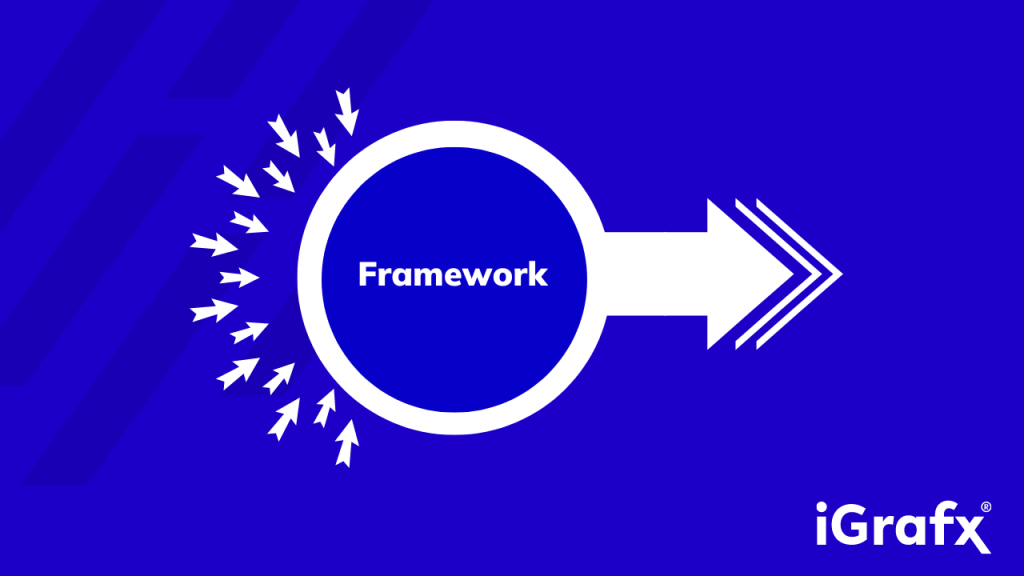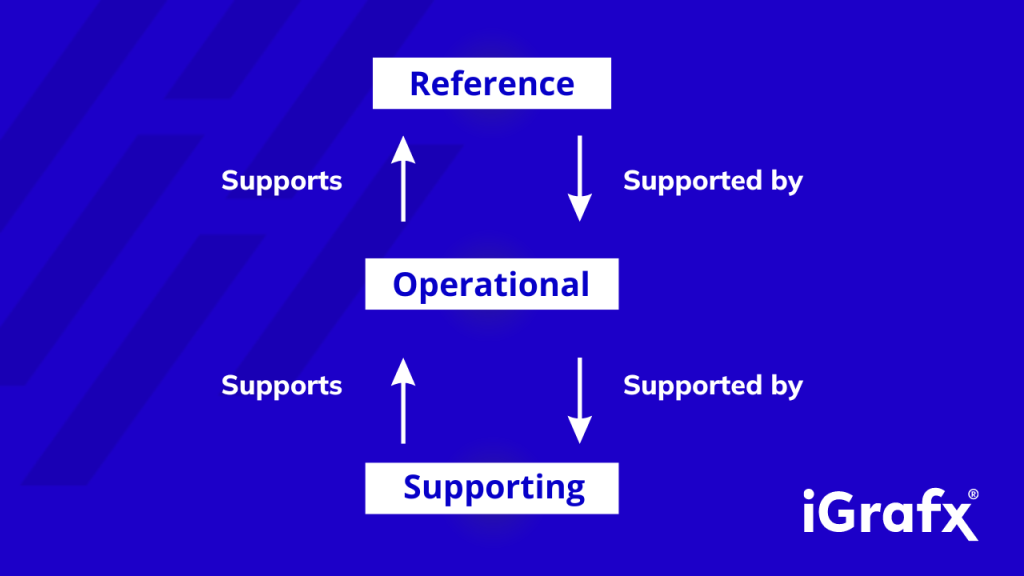By Kim Scott, iGrafx Senior Consultant
Act 1: In the beginning, there was Chaos… and it was good?
You can find all sorts of quotes, and even theories, about chaos. For example, according to Simon Sinek: “Chaos is needed for innovation. Structure makes those ideas useful.” There’s a balance between chaos and structure in process framework methodology.
To elaborate on this: without a structured approach to executing on those ideas that become your products and services and executing the corresponding processes repeatedly and in a high-quality manner, you’re likely to have too much chaos.
While ‘innovation’ processes need some amount of flexibility and chaos, most processes do not benefit from chaos. Many processes have variation or entire variants. Whether the variations are from geographical or regulatory differences, mergers and acquisitions that aren’t finished, or simply personal preferences allowed to reign over how things are done, there are good reasons—and often not-so-good reasons—for those variations. In addition to the variations within a given process, that process is (or all those variations on the process are) very likely to interact with other processes, and the chaos compounds and grows.
I wrote some time ago about seeing the process forest and the trees. I wrote how not understanding the effects that a process change will have on the process or downstream (or even upstream) processes, it is possible to sub-optimize by improving a process that is a sub-process when looked at in a larger context. Furthermore, you risk wasted effort: including pieces of other processes in the one you’re working on, repeating information in process diagrams that belong in Procedures, missing hand-offs between processes, missing requirements that a process has for the larger context, or missing areas where process re-use can occur.
What can help alleviate the complexity and chaos of real-life processes is how they fit into Frameworks of information – a Process Architecture or ‘Landscape’ for Processes, and other well-organized taxonomies for Strategies, IT Architecture, etc. This can be ‘organized chaos’ for innovation (e.g., ‘Research and Development’) processes, and more rigorous and standardized for non-innovation processes.
If we accept that structure in the chaos is a good thing, then, what’s next? How do we go about creating this structure? How do we pick a framework, or frameworks?
Act 2: Staring at the Blank Page… and Then Picking a Framework
So, then, where does one start to make order out of the chaos? Having a process framework can be incredibly useful to organize the chaos in a meaningful way.
However, much like I started writing this article by staring at the ‘blank page’ of my word processor, I’ve experienced many enterprises that either don’t have organizing framework(s), or how that enterprise’s current structures do not have industry ‘best-practice’ metrics (KPI’s) nor sufficient breadth and flexibility to handle all the areas of the enterprise’s processes that must be managed.
The sad truth of the state of framework use within process excellence efforts is that, even for entities that are likely to use frameworks— such as those that recently responded to APQC’s “Best Practices in Applying Process Frameworks” survey— about ¼ of enterprises don’t use a Framework at all. This implies that there’s no organizing structure, methodology, metrics, notations, etc. in place to help effectively manage the complexity of real-life work. Furthermore, for those that are using a framework, about 60% use the equivalent of a shared network drive, versus a cloud-based SaaS application.
In fact, most enterprises are managing their process framework in a spreadsheet. This means that most enterprises are missing out on the database-driven software solutions that are created for discovering, designing, analyzing, and managing any desired type of process. These SaaS solutions possess the ability to manage a vast number of processes and related business modeling data, in a multi‐user environment. These solutions often maintain thousands of processes, in a way that scales well for use throughout the enterprise. iGrafx® Process360 Live is, of course, one of those SaaS solutions.
Even if you have chosen a SaaS application like Process360 Live from iGrafx to model your enterprise and manage your framework(s), the question remains about which framework will best fit your needs.
There’s a phrase I like: The ‘wonderful’ thing about ‘Standards’ is that there’s so many of them! Frameworks aren’t far behind standards in their proliferation. The APQC Process Classification Framework (PCF) claims to be “the world’s most widely used business process framework.”
The APQC survey referenced above mentions various frameworks (e.g., the PCF, SCOR, ITIL, Baldridge, eTOM, etc.). In addition, the detailed and informative “What’s Your Baseline?” article on “Enterprise Architecture Frameworks, Methods, Notations, Reference Content” also mentions a few more frameworks (TOGAF, DoDAF, Zachman).
So, which process framework(s) to pick? I’m not a fan of binaries (outside of their usefulness in computing); you don’t have to pick any framework, nor do you have to pick only 1 framework. It’s important to select an approach that’s ‘fit for purpose.’ While this might be picking a single process framework, and that can make the task simpler, you don’t need to limit yourself to an ‘off-the-shelf’ framework, or at least not to a single off-the-shelf framework.
While I believe that a process framework is a powerful approach for creating needed order out of the chaos, what would you be using the framework to do? It’s important to be clear on what the framework will do for you; the ‘why’ you need a process framework. For example, consider the following questions. Do you want the framework to:
- Help you discover processes that already exist in your enterprise? Improve them?
- Provide structure to a technology implementation or upgrade?
- Benchmark your way of doing things against others’ approaches, or accepted ‘best practices’ in the industry?
- Have a ‘content management’ approach; like the ‘Universal Decimal Classification’ is to human knowledge? Are you hoping that your framework will align people with their expectation of an easy way to find the content that they are looking for; reducing the time spent for searching content, and in training or retraining them?
All of these are great reasons to use a process framework. Most enterprises use process frameworks for identifying and standardizing their processes. A framework can also be useful for managing the performance of processes, identifying improvement opportunities, and reaching an improved future state.
Once you have the ‘why’ you’re looking for a process framework, it’s time to switch to the ‘What can it do for me?’
- Does it have sufficient breadth to include all the processes that you need it to structure?
- Is it sufficiently detailed to help you jump from a generic classification system to the reality of how you operate?
- Does it match your specific industry or way of working?
- Does it define additional information that will accelerate your work in using it, or to evaluate how you’re doing in your process efforts?
- Does it have metrics (e.g., Key Performance Indicators) on processes, definitions for each process, and/or reference material or benchmarks available?
A reminder that, while I’m talking about a singular framework here, the answer could very well be ‘no’ to some or all the questions above. It is possible, likely even, that a single framework cannot be ‘all things to all people’ (even though we may want the ‘One framework to rule them all…’ 😉).
Before I dive into talking about making use of a framework a reality, let’s consider that you can have one or more reference frameworks, an operational framework that can be based on one or more reference frameworks, and even a supporting ‘system’ framework for each major application (e.g., an ERP system like SAP, Microsoft, Oracle, etc.).
The reference framework(s) are one of the ones discussed above (PCF, SCOR, Baldridge, ITIL, etc.). These are ‘industry best-practice’ reference models, that allow you to benchmark your processes against. They often have detailed information, sufficient breadth, metrics, and even other reference information.
The PCF has all these attributes. If you relate the PCF as a reference structure to your operational process framework, then you can ‘benchmark’ whether you have a process that the reference structure indicates, whether you’re meeting metrics it defines, etc.
The Operational framework reflects what you do now, in real life. If you don’t have an existing framework or ‘architecture’ defined or documented, you can choose to start with the PCF as the ‘seed’ to guide how you understand and align what you’re doing with ‘in real life’ with the ‘best practice’ reference framework. You can change names, re-arrange hierarchies, add or delete processes as needed.
This is where ‘things get real.’ You must either ‘map’ what you’re doing now to a single framework like the PCF, take elements of multiple frameworks and adapt them to fit what you’re doing (e.g., replace the IT section of the PCF with ITIL framework items), and/or discover and invent your own framework.
If doing the latter, you need to be careful to have consistent hierarchical leveling, naming conventions, clarity on the depth and breadth of information you’re going to, etc. In other words, you’ll have to try to answer ‘yes’ to as many of the questions from above as you can. It is the activities within this framework — the leaf level of the hierarchy — that will reference ‘desktop procedures’ or ‘standard work instructions.’ It is too much detail to put ‘procedure’ level information (e.g., “Click F6 to…”) in an operational process.
The System or ‘Supporting’ framework reflects the structure within your systems; within the IT Architecture applications used by your enterprise. For example, your ERP system (e.g., from SAP, Microsoft, Oracle, etc.) probably defines a set of activities, perhaps organized into steps, processes, etc. This is the ‘implementation’ layer of detail.
You may find it useful to define, and even diagram in BPMN, the intended implementation of your business processes. This is too much detail for the operational level, and yet can be powerfully useful for communicating to implementers what they must specifically code (including the implementers using a BPMN diagram to communicate what will be coded to the business users asking for the implementation).
So, once you pick a framework, or frameworks, how do you ‘operationalize’ it? How do you use it in real life, to accomplish the ‘why and what’ you need it to help with?
Act 3: The House that a Process Framework Built (Operationalizing a Framework in Process 360 Live)
We’re going to consider how you go from picking a framework to using one. To do this, we’ll need something concrete enough to discuss the implementation of a framework in ‘real life.’ As such, I’ve assumed that you are doing so in Process360 Live. Why, you ask? Well, you have come to iGrafx to find this information. In addition to assuming you’re using Process360 Live, I’ll broadly assume you have chosen the APQC PCF (or PCF for short) as the foundation on which to build your Framework(s). It is the framework I most often recommend to my customers, and ‘ticks the boxes’ for most (if not all) of reasons for a Framework listed in Act 2.
Now that we’ve chosen the PCF as our framework, how can we create it in Process360 Live for use? Given that there are many thousands of processes and metrics, typing it all in by hand would be cumbersome and error-prone. With the REST API available with Process360 Live, it’s possible to import data from various sources — including the Microsoft Excel spreadsheets that the PCF is delivered in– into Process360 Live.
The consultants at iGrafx can help you use the iGrafx Data Input Output tool (IDIO) to format data in such a way that the IDIO REST API program built on top of Excel as a macro can be used to import vast amounts of data. This makes it relatively straightforward to import the PCF, or any other reference framework in the proper format, into Process360 Live.
You can also, of course, seed the Operational Framework this way if desired, and even create the ‘folders’ that diagrams which visualize (‘Describe’) the process structure will live in. Our consultants can, of course, assist you with the effort of applying a framework like the PCF in a consistent manner, and in learning how to map what you’re doing in real life to the structure the PCF (or another framework) defines.
One of the key questions I receive from customers is ‘How do I navigate people to the process they need?’ The beauty of having a consistent framework to structure your processes is that you can get to the expected ‘home’ of the process by various methods, as you know where it lives, and yet aren’t locked into getting there through the framework structure. For example, you can build a diagram with isometric drawings that represent the entire enterprise (e.g., the branch of a financial institution), or if you want to ‘see’ the framework visualized as a ‘house’ that is aligned to the top level of the PCF, you can display these ‘navigational’ type diagrams on the dashboard.
While a SaaS application like Process360 Live has powerful searching capabilities, it’s more friendly to either have a navigational diagram, or even a report showing relevant processes for a given audience. The Process360 Live Design module’s dashboarding capabilities allow you to do all the above. Again, note that your navigational scheme doesn’t have to match the process framework structure; you can navigate people to content in any way that will work for them. The dashboard can also, of course, display reports to help find processes, and/or metrics that are measuring the processes within your enterprise.
So, in conclusion, having a framework is a powerful way to bring ‘enough’ structure to the chaos of what’s happening within your enterprise, to be able to benchmark against ‘best practices,’ and even to help people efficiently access the process and related knowledge they need. I wish you success with innovating a structure that is useful for your endeavors.
Interested in learning more about how iGrafx can help you jump-start your organization’s process maturity? Try a free demo of our Process360 Live platform to enable seamless process optimization with process mining, process design, analysis, simulation and process automation.



